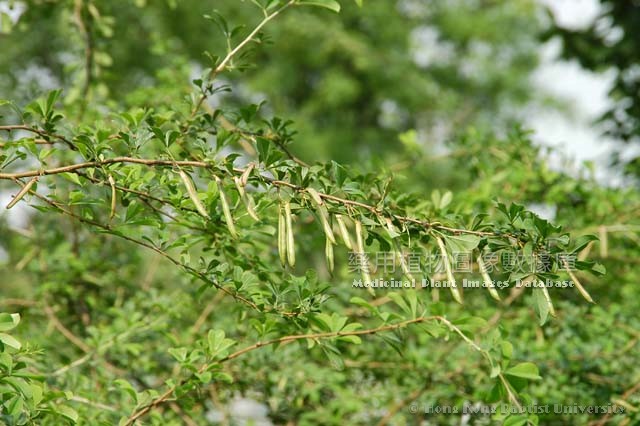|
Caragana sinica (Buchoz) Rehd.

|
English Name |
Chinese Peashrub, Chinese Pea Tree, China Peashrub, Chinese Pea-shrub |
|
Latin name |
Caragana sinica (Buchoz) Rehd. |
|
Family & Genus |
Fabaceae, Caragana |
|
Description |
Deciduous shrubs, 1-2m tall. Branchlets slender, with edges, glabrous, yellow brown or grey. Even-pinnate compound leaves, clustered on short branches, solitary on twigs, leaf axis persistent, top hardened into acupuncture shape, stipules triangular, hardened into acupuncture shape, about 8mm long; leaflets 2 pairs, pinnate arrangement, obovate, sessile, one pair at the top often larger, 5-18mm long, top slightly concave, with short tips, base cuneate, both sides glabrous. Flowers solitary within clustered leaves of short branches, pedicels about 1cm long, calyx campanulate, 12-14mm long, 6-9mm wide, papilionaceous flowers, yellow or deep yellow, brown red when faded, vexils narrowly obovate, with short valvular stalks, petals slightly longer than vexils, ears short, keels broadly blunt; ovary of pistil glabrous. Pods slightly flat, glabrous. Flowering: April to May; fruiting: July. |
|
Distribution |
Growing in forest edges, on roadsides, in thickets and in mountain slopes. Distributed in Hebei, Shaanxi, Henan, Jiangsu, Zhejiang, Fujian, Jiangxi, Sichuan, Guizhou, Yunnan and etc. The medicinal materials are mainly produced in Hebei, Shaanxi, Henan, Jiangsu, Zhejiang, Fujian, Jiangxi, Sichuan, Guizhou, Yunnan and etc. |
|
Part Used |
Medical part: flowers and roots. Chinese name: flowers: Jinjier. Roots: Jinjiergen. |
|
Harvest & Processing |
Flowers: collected in April and May when in full bloom, sun-dried or baked to dry. Roots: excavated in autumn, well washed, sliced and sundried. |
|
Chemistry |
Roots contain sterols, such as β-sitosterol, cholesterol, campesterol; saponins, such as kalopanax saponin F, and caraganoside A, etc. |
|
Pharmacology |
Flower: ant-tumor, and anti-viral. Root: hypertension-lowering. |
|
Properties & Actions |
Flower: sweet, little warm. Root: sweet, pungent, little bitter, neutral.Flower: removing wind, activating blood, checking cough, clearing phlegm. Root: tonifying and strengthening, activating blood, regulating menstruation, removing wind and inducing urination. |
|
Indications & Usage |
Flower: Used for dizziness and tinnitus, cough due to deficiency of the lung, infantile dyspepsia. Root: Used for hypertension, dizziness and lightheadedness, tinnitus and blurring of eyes, weariness and debilitation, irregular menstrual periods, leucorrhea, insufficient breast milk, pain of rheumatic joints, injuries caused by falls.Flower: oral administration: decocting, 3-9g. Root: oral administration: decocting, 9-18g. |
|
Examples |
Root:
Irregular menses: catnipr root peel 6-9g, radix codonopsitis 6-9g. Cook in water and drink. |
|

